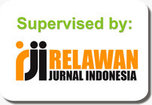USABILITY EVALUATION MODEL USING CONFIRMATORY FACTOR ANALYSIS ON ONLINE BUYING SITES
Abstract
The data obtained from the Top brand index shows that there are 3 market leaders of online buying and selling sites in Indonesia, namely lazada.co.id; shopee.co.id and tokopedia.com. This makes the reason for choosing the object of research with the aim of research to find out the usability evaluation model using confirmatory factor analysis. The research data were obtained by distributing questionnaires as many as 150 respondents to 3 market leader online trading sites in Indonesia, namely lazada.co.id; shopee.co.id and tokopedia.com. The five components that will be used to turn into a questionnaire are learning ability, memory, efficiency, errors, satisfaction. The results showed that the design of the model in solving this particular problem is needed to measure the level of suitability of the use of the technology being made, so that research that has been carried out using the CFA method for the usability evaluation model can be concluded that by using 5 latent variables and 22 constituent indicators, resulting latent variables which are very influential in evaluating usability on online buying and selling sites. The results of the data analysis on questionnaire filling conducted by respondents were based on five variables, namely learnability, memorability, efficiency, errors and satisfaction, namely the most important factors in usability evaluation were memorability, efficiency, errors, with each index value of 5.60 in the very high category. Meanwhile, the Learnability factor has the lowest score of 5.56.
Keywords
Full Text:
PDF (Bahasa Indonesia)References
Andhini, A., 2017. Pengaruh Transaksi Online Shopping, Dan Kepercayaan Konsumen Terhadap Kepuasan Konsumen Pada E-Commerce. Jurnal Ilmu dan Riset Manajemen Volume 6, Nomor 7, Juli 2017
Arumi, E.R; Sukmasetya, P.; Setiawan, A. 2021. Model Evaluasi Usability Menggunakan Confirmatory Factor Analysis Pada Krs Online. Jurnal Teknologi Informasi dan Ilmu Komputer (JTIIK) Vol. 8, No. 1, Februari 2021, hlm. 95-102.
Ayudhitama, A.P. dan Pujianto, U. 2019. Analisa Kualitas Dan Usabilitas Berdasarkan Persepsi Pada Website Shopee. Jurnal Informatika Polinema Vol. 6, Edisi 1, November 2019.
Bott, M. et al., 2018. Confirmatory Factor Analysis Alternative: Free, Accessible CBID Software. Western Journal of Nursing Research, 40(2), pp. 257 269.
Efendi, M. M. dan Trijoyo, D., 2012. Analisis Faktor Konfirmatori untuk Mengetahui Kesadaran Berlalu Lintas Pengendara Sepeda Motor di Surabaya Timur. Jurnal Sains Dan Seni Its, 1(1), pp. D106 D111.
Foster, B. 2017. Impact of Brand Image on Purchasing Decision on Mineral Water Product Amidis (Case Study on Bintang Trading Company). American Research Journal of Humanities and Social Sciences, 2(1), 1 11.
Ghozali, I. 2008. Model Persamaan Struktural konsep dan Aplikasi dengan program Amos 16.0. Badan Penerbit UNDIP. Semarang.
Ghozali, I. 2011. Aplikasi Analisis Multivariate dengan Program SPSS, Semarang: BP-UNDIP.
Hair, J. F., Anderson, R. E., Tatham, R. L., & Black, W. C., 2010. Multivariate Data Analysis, New Jersey: Prentice-Hall International, Inc.
https://www.topbrand-award.com
Kotler, P. dan Keller, 2007, Manajemen Pemasaran, Jakarta : PT. Indeks.
Kusumah, M.A.A; Rokhmawati, R.I. dan Amalia, F.. 2019. Evaluasi Usability Pada Website E-commerce XYZ Dengan Menggunakan Metode Cognitive Walkthrough dan System Usability Scale (SUS). Jurnal Pengembangan Teknologi Informasi dan Ilmu Komputer Vol. 3, No. 5, Mei 2019, hlm. 4340-4348.
Nanehkaran, Y.A. 2013. An Introduction to Electronic Commerce. International Journal Of Scientific & Technology Research. Volume 2, Issue 4.
Prayoga, S.H. dan Sensuse, D.I. 2010. Analisis Usability Pada Aplikasi Berbasis Web dengan Mengadopsi Model Kepuasan Pengguna (User Satisfaction). Journal of Information System Vol. 6, Issue. 1, April 2010.
Qashlim, A.; Prahasto, T. dan Gernowo, R., 2014. Evaluasi Human Machine Interface Menggunakan Kriteria Usability Pada Sistem E-learning Perguruan Tinggi. Jurnal Sistem Informasi Bisnis Vol. 02 Tahun 2014.
Rezaei, S.; Amin, M. dan Abolghasemi, M. 2013. User Satisfaction With Mobile Websites: The Impact of Perceived usefulness (PU), Perceived Ease 0f Use (PEOU) And Trust. Nankai Business Review International, 5(3), 258-274.
Setiawan, A. ET AL., 2018. Evaluasi Website Perguruan Tinggi Menggunakan Metode Usability Testing. 03(03), pp. 295 299. doi: 10.30591/jpit.v3i3.912.
Suhaily, L., & Soelasih, Y. 2017. What Effects Repurchase Intention of Online Shopping. International Business Research, Vol. 10 No. 12.
Tandon, U., Kiran, R., & Sah, A. (2017). Analyzing customer satisfaction: users perspective towards online shopping. Nankai Business Review International, 8(3), 266 288.
Yuliani, O. dan Prasojo, J. 2016. Evaluasi Usability Situs Web Sistem Informasi Akademik (Studi Kasus Pada STTNAS Yogyakarta). Prosiding Seminar Nasional XI Rekayasa Teknologi Industri dan Informasi 2016 Sekolah Tinggi Teknologi Nasional Yogyakarta.
DOI: http://dx.doi.org/10.26623/transformatika.v19i2.3624
Refbacks
| View My Stats |
Jurnal Transformatika : Journal Information Technology by Department of Information Technology, Faculty of Information Technology and Communication, Semarang University is licensed under a Creative Commons Attribution 4.0 International License.









